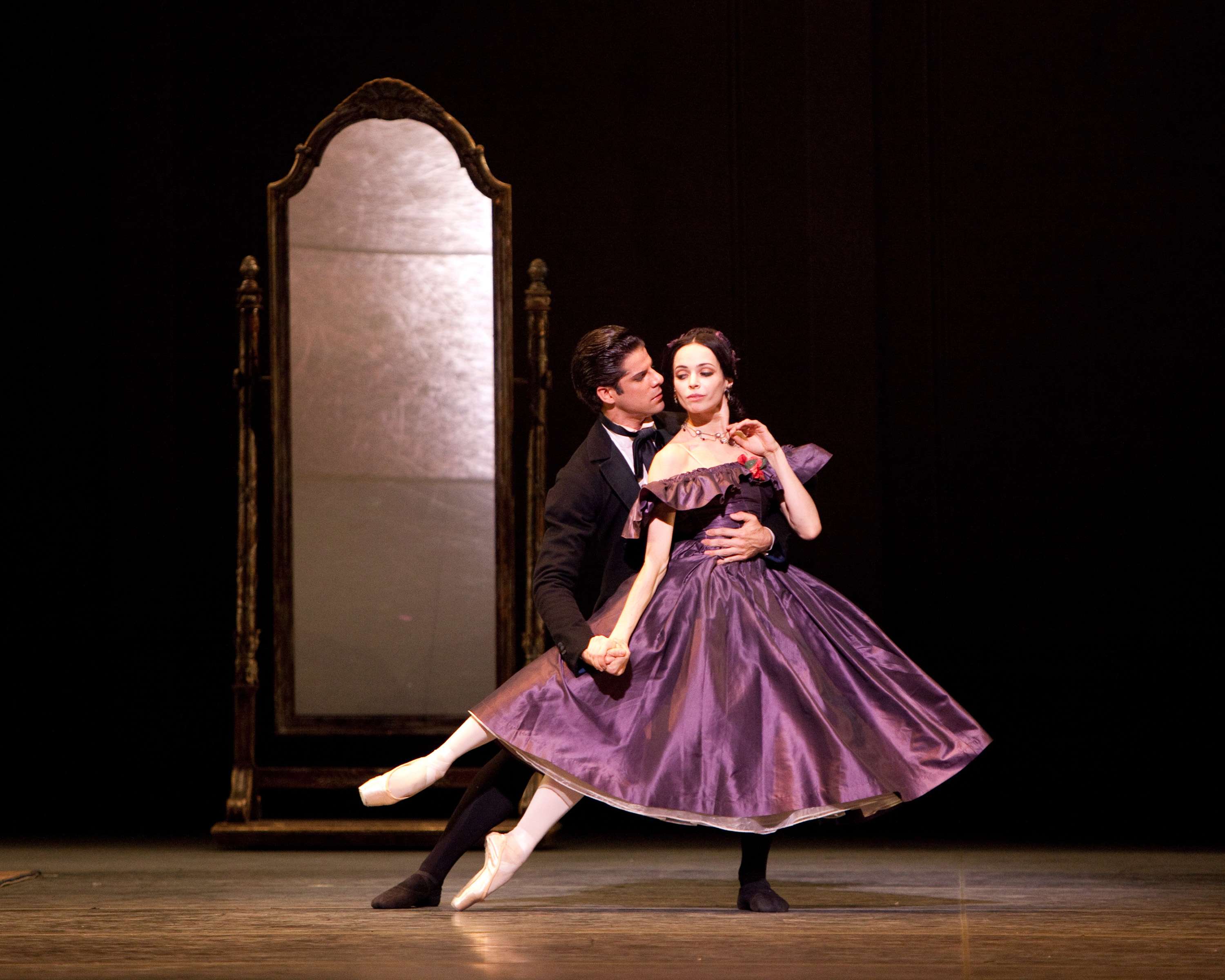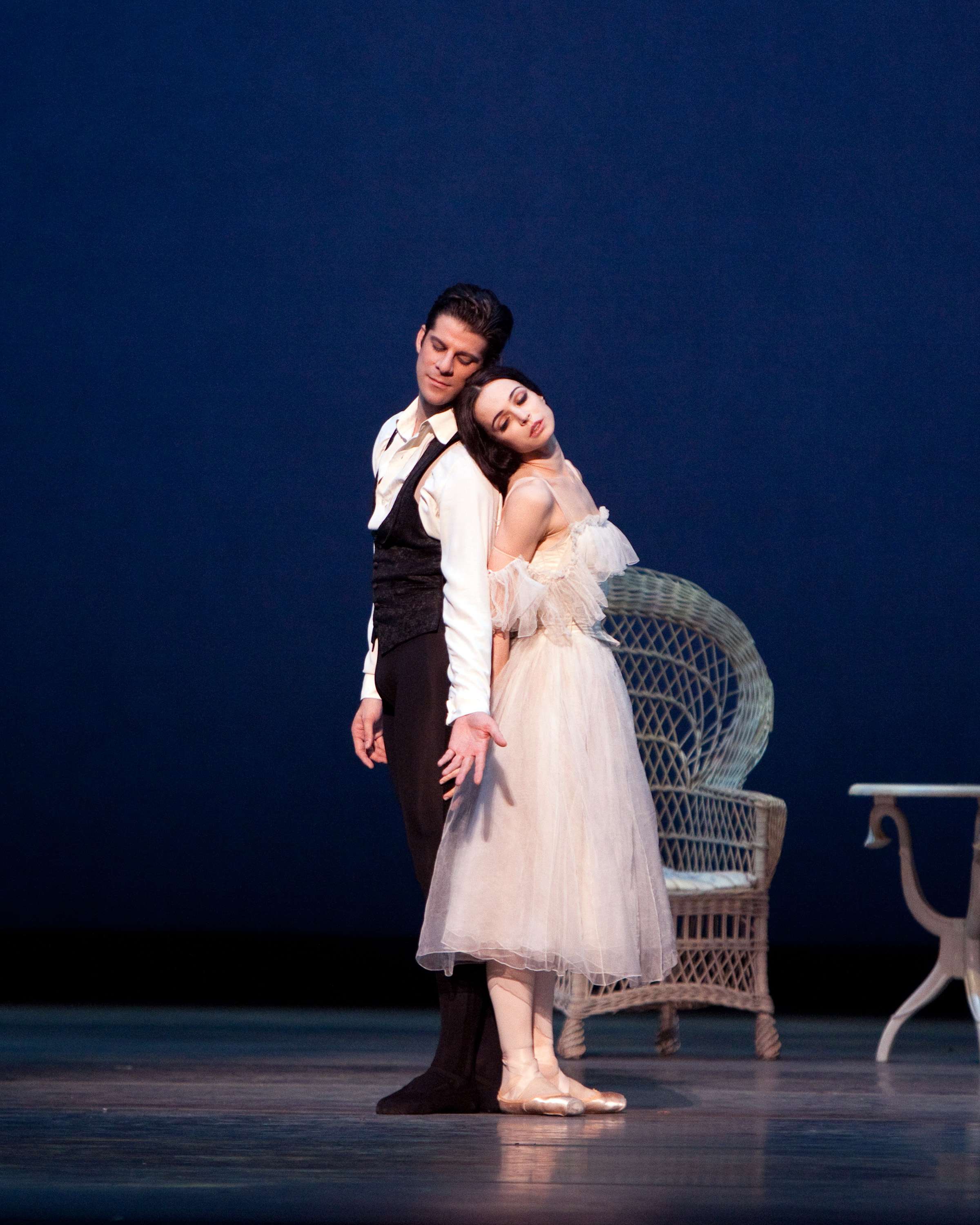|
Back
End of the Affair New York
The Metropolitan Opera House
06/03/2011 - and June 4m*, 4e, 6, 7, 8m, 8e, 2011
Frédéric Chopin: Lady of the Camellias
Diana Vishneva (Marguerite Gautier), Marcelo Gomes (Armand Duval), Veronika Part (Manon Lescaut), Eric Tamm (Des Grieux), Roman Zhurbin (Monsieur Duval), Nicola Curry (Norina the Maid), Isaac Stappas (The Duke), Simone Messmer (Prudence Duvernoy), Alexandre Hammoudi (Gaston Rieux), Maria Riccetto (Olympia), Marcello Lopez (Count N.), The American Ballet Theatre Corps de Ballet Ornsby Wilkins (Conductor)
Koji Attwood, Nimrod Pfeffer, and Emily Wong (Pianists)
John Neumeier (Choreography and Lighting Design), Kevin Haigen and Victor Hughes (Staging), Jürgen Rose (Set and Costume Design), Ralf Merkel (Lighting Reconstruction)

M. Gomes, D. Vishneva (© Rosalie O’Connor/American Ballet Theatre)
La traviata, one of the first operas I ever saw, is part of my cultural landscape. Verdi, at the height of his powers, transfigured the Dumas story and made Violetta and Alfredo immortal. At the Metropolitan Opera House this season, we have had the opportunity to experience this tragic love story afresh – first in the Willy Decker production of La traviata, and now in the brilliantly beautiful, dramatically compelling, and infinitely touching American Ballet Theatre offering, Lady of the Camellias, choreographed by John Neumeier.
First performed in Hamburg in 1978 and debuting in New York only last year, this ballet is an utterly romantic dreamscape with a simple, elegantly stylized staging, and sumptuous costumes, both by Jürgen Rose. The story unfolds out of time -- in the memories of Armand and also his father – beginning at an auction house where the possessions of Marguerite are up for sale. Lady of the Camellias is a ballet about relationships and, as such, the choreography is built around the pas de deux. This is not the usual celebration of technical virtuosity with show-stopping dancing provoking bursts of applause. Instead, Neumeier gives us ballet as drama, with every glance, gesture, and dance step tied directly to the imperatives of delineating character, expressing emotion, and telling the story. Each of the minimal props (the most crucial of which is Marguerite’s mirror), is perfectly placed, creating tableaux so stunning that they could have been paintings. Over and over again, I was reminded of the visual arts – of Manet, Renoir and, in the promenade scene, Seurat’s magical La Grande Jatte. Neumeier and Ralf Merkel create marvelous dramatic and even poetic effects simply by manipulation of light, including the house lights. Space becomes infinite as it merges with time in the realm of memory.
We are constantly – and cleverly – reminded of the artifice of it all by various touches, large and small. There is no curtain; their space becomes our space. During the prologue, Armand rushes into the auction house. He is so bereft at Marguerite’s loss and the recent revelation of her sacrifice that, he collapses. Coming to his aid is the first of our three pianists, who has been picking out on the piano what will become a kind of signature tune for the mingling of love and grief – the largo from the Sonata in B Minor by Chopin. Act one begins at a ballet, Manon Lescaut, as we and the dancers watch a pas de deux by Manon And Des Grieux. Later, these two step out from behind the proscenium and become characters in the ballet; Manon, as a courtesan who met a bad end, becomes an emblem of Marguerite’s fate, a momento mori of her death. One of the most gripping moments in this extraordinary ballet is a pas de trois in which Manon and Des Grieux appear to Marguerite shortly before she dies.
In Willy Decker’s La traviata, the curtain was also initially open, but the set – a unit set -- could not have been more different. The space was claustrophobic, a bull ring from which for poor Violetta, there was no escape. She was pursued, even hunted down, like an animal, a wild creature without dignity treated without humanity. In Decker’s stark, brutal, reduction, this was woman as sex object, a prostitute drooled over and, pursued by a mob – the chorus, men and women both, clad in dark suits. The set was muted with the only splashes of color being Violetta’s red dress and the red couch on which she sat. This production marked a shocking and fascinating departure for New York audiences for this one of Verdi’s most beloved operas, who have been fed a steady diet of the absurdly cluttered and undramatic Zeffirelli stagings. (He directed both the last production at the Met and the one before that.) For Decker, the atmosphere is almost unremittingly bleak. Violetta’s fate is ordained from the outset, with her doctor (clearly a personification of death) a constant stage presence, and a huge clock ticking away relentlessly. In this context, there was no joy in her partying, just a frenzied embrace of life. Both the chorus, peering over the edge of the set, and we the audience became voyeurs – as in a bull ring – watching the unfolding tragedy of Violetta. In act two, Neumeier’s ballet has merely a momentary allusion to such an impersonal, predatory mob. Marguerite has just given in to the entreaties of M. Duval (the excellent Roman Zhurbin), whose rigid posture and gestures and angular stride embody his implacable will. After he departs, Manon appears and the two courtesans dance together, watched by men in formal dress huddled together stage right.
The two principal dancers, Diana Vishneva and Marcello Gomes, were simply superb. Ms. Vishneva, who will appear later this summer as Anna Karenina with the Mariinsky Ballet, presented by the Lincoln Center Festival, was lithe and graceful but also expressive and emotional. She conveyed the whole range of the interior life of Marguerite. The elegant arc of her arms, the way she seems to drift downward from being en point, her furious yet perfectly balanced turns were stunning. Vishneva has a body that can do virtually everything; indeed, she can even transmute that body into into one that seems to be gradually losing its strength. And, before that, she gave physical presence to the tenderness and passion of her growing love for Armand as they wrapped themselves around each other in a way that was both impossibly graceful and tremendously moving.

M. Gomes, D. Vishneva (© Rosalie O’Connor/American Ballet Theatre)
Marcello Gomes, with his aristocratic carriage and tremendous upper body strength (on display as he repeated lifted his partner) was so expressive -- in shyness, in joy, and most especially in torment. The image of him sweeping across the stage, like a great bird, spine arched, arms flailing – into the wings, then out again, then in and then out – was shattering and simply unforgettable. He returns later this season in two performances each of Swan Lake, Cinderella, and Sleeping Beauty. Veronika Part and Eric Tamm, as Manon and Des Grieux, were elegant and expressive, particularly Ms.Part. As her Manon drew Ms.Vishneva’s Marguerite into an embrace of death, the two almost seemed to merge.
The impeccably selected Chopin pieces included his entire second piano concerto and the second movement of his first, as well as ballads, polonaises, waltzes, and other solo piano pieces, most hauntingly the Sonata in B minor. The three pianists played with great sensitivity and skill, never overshadowing the dancers and always remaining a part of the rich artistic fabric, the totality of which made this performance a triumph. Their articulation, rubato and dynamic control were exemplary. The orchestra under Maestro Wilkins was particularly fine as the woodwinds emerged from the overall texture for a lovely interplay with the piano line.
Arlene Judith Klotzko
|